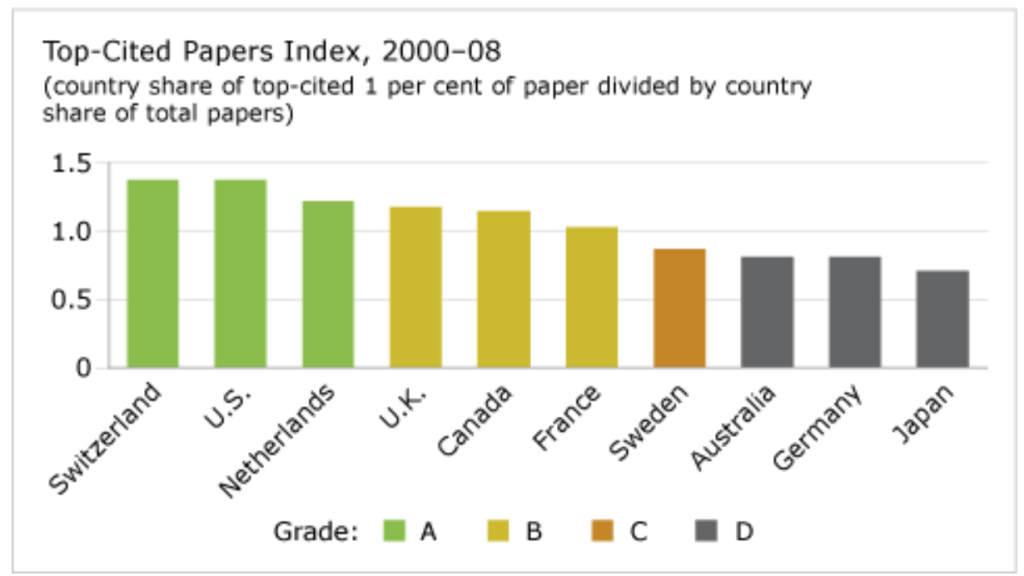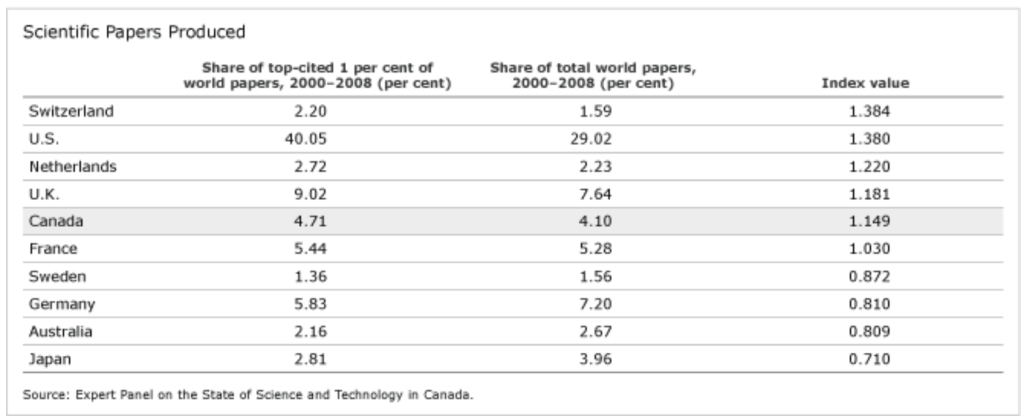Top-Cited Papers Index
Key Messages
- Canada gets a “B,” indicating that its scientific research is of relatively high quality.
- Research in many science and technology fields is disseminated through the peer-reviewed journal.
- This index assesses research quality—not just a straight compilation of publication counts.

Why are top-cited papers important to innovation?
Peer-reviewed publications are an essential part of research, which itself is a key part of innovation. In many science and technology fields, peer-reviewed journal articles are the main way to communicate research advances.1
But straight publication counts merely provide an indication of the quantity of research output—they do not reflect the quality or impact of that research.2
In that sense, they do not provide a measure of seminal research—the research that influences other research. One remedy to this situation is citation counts, which measure the extent to which published articles have influenced the development of later research. Citation counts measure the impact of specific research that feeds innovation.
What does the report card measure and how are grades assigned?
This indicator is evaluated slightly differently than the methodology described in the Methodology section.
This report card measures the share of the top-cited 1 per cent of scientific papers as a proportion of the share of total scientific papers published in the world, per country. A value greater than 1 means that a country’s share of top-cited papers is proportionately greater than its share of total papers, implying higher-quality research. In other words, if the ratio of a country’s share of top-cited 1 per cent of papers to its share of all papers is greater than 1, this implies that the influence of its scientific output is greater than its share of scientific output. If the ratio is equal to 0, this implies that the influence is equivalent to its output. A score less than 1 implies that the influence is below its output.
Countries with an index value greater than 1 were given an “A” or “B” grade. We took the difference between the value of the best-performing country and 1, divided by 2, and assigned an “A” to countries in the top half and a “B” to countries in the bottom half. Countries with an index value less than 1 were given a “C” or “D” grade. We took the difference between the value of the worst-performing country and 1, divided by 2, and assigned a “C” to countries in the top half and a “D” to countries in the bottom half.
How does Canada’s performance compare to its peers?
Canada ranks in fifth place and earns a “B” grade. Five other countries also have a ratio greater than 1, indicating that their share of top-cited papers is proportionately greater than their share of total papers.
Who are the leaders in this report card?
Switzerland, the U.S., and the Netherlands each earn an “A” grade. Switzerland’s performance is notable, with 2.2 per cent of the world’s top-cited scientific papers and only 1.6 per cent of the world’s overall scientific papers. This results in an index value of 1.384 and suggests that Switzerland produces highly influential research.
The U.S. also receives an “A” grade, with 40 per cent of top-cited papers and 29 per cent world papers—resulting in an index value of 1.380. The Netherlands generates an index value of 1.220, thanks to 2.72 per cent of the top 1 per cent of citations relative to its 2.2 per cent share of total world scientific papers. Similarly to Switzerland, this indicates a high amount of leading-edge research.
Canada had 4.71 per cent of the top-cited papers and 4.1 per cent of overall scientific papers, over 2000 to 2008, leading to an index value of 1.149.

Each of the countries rated “A” has well-established research institutions and traditions. In addition to its traditional university sector, Switzerland’s research output is boosted by the European Council for Nuclear Research (CERN). The performance of the U.S. is supported by its vast research ecosystem in academia, government, and business. Meanwhile, the performance of the Netherlands resembles that of Switzerland; the country is responsible for a small proportion of publications (2.2 per cent), but these publications tend to be relatively influential.
The position of the U.K. is similar to Canada; its 7.65 per cent of all world publications garner 9.02 per cent of all top 1 per cent of citations, implying that the quality of its research is very high.
What can Canada do to improve its grade?
The influence of Canada’s scientific research is already greater than the proportion of research, a fact that was acknowledged in a recent OECD economic survey of Canada: “Canada’s performance as a global science and technology leader has long been a policy objective, one that has to a large extent been achieved in the realm of academic output.”3
Increasing the effectiveness of its scientific research would appear to require Canada’s research to be even more influential, which may prove difficult in view of the large institutional research frameworks that the top countries have compared with Canada.
However, the OECD also cautions that Canada’s innovation policy as a whole remains viewed through a traditional science and technology lens that is “centered on the universities, though this is slowly changing in line with growing recognition of a commercialization gap between academic and applied research.”4
This imbalance—between world-class academic research and lacklustre business R&D—resulted in the establishment of an expert panel to review federal support to R&D. The panel’s report recommends a reconfiguring of current R&D funding to boost business innovation.5
Footnotes
1 Expert Panel on Business Innovation, The State of Science and Technology in Canada, 2012 (Ottawa: Council of Canadian Academies, 2012), 38.
2 Ibid., 47.
3 OECD, Economic Survey of Canada 2012 (Paris: OECD, 2012), 53.
4 Ibid.
5 Independent Panel on Federal Support to Research and Development, Innovation Canada: A Call to Action (Ottawa: Public Works and Government Services Canada, 2011).

